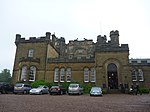Crichton Castle

Crichton Castle is a ruined castle near the village of Crichton in Midlothian, Scotland. It is situated at the head of the River Tyne, 2 miles (3.2 km) south of the village of Pathhead, and the same distance east of Gorebridge. Constructed as a tower house in the late 14th century, it was expanded as the power of the Crichton family grew. However, the Crichtons fell from favour in the later 15th century, and the castle passed to the Earls of Bothwell. Francis Stewart, 5th Earl of Bothwell, constructed the Italianate north range in the 1580s, featuring an elaborate diamond-patterned facade. After Bothwell was accused of witchcraft the castle fell into neglect. The ruins are now in the care of Historic Environment Scotland, and are open to the public. A mile to the south-west is Borthwick Castle, a 15th-century tower house that is still in use.
Excerpt from the Wikipedia article Crichton Castle (License: CC BY-SA 3.0, Authors, Images).Crichton Castle
Colegate Road,
Geographical coordinates (GPS) Address Nearby Places Show on map
Geographical coordinates (GPS)
| Latitude | Longitude |
|---|---|
| N 55.8411 ° | E -2.9895 ° |
Address
Crichton Castle
Colegate Road
EH37 5XA
Scotland, United Kingdom
Open on Google Maps











